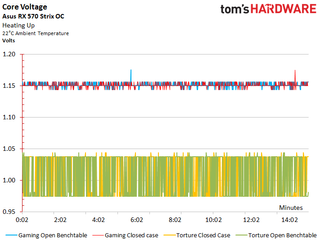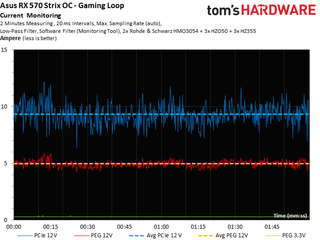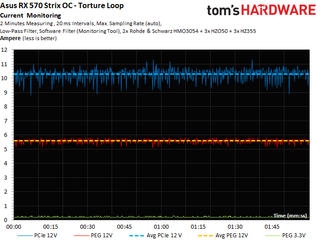AMD Radeon RX 570 4GB Review
Why you can trust Tom's Hardware
Power Consumption
Our exploration of power consumption begins with a look at the Strix RX 570 OC as it performs different tasks.
Similar to Radeon RX 580, AMD introduced an intermediate memory clock state so that the GDDR5 doesn't have to run at full speed with multiple monitors attached or while playing back video content. So long as your displays are set to the same resolution, this approach works just as well for Radeon RX 570.
When it comes to gaming, though, the card breaks out of its shell. A 30 MHz-faster GPU and a higher memory clock rate result in an additional 13W of power consumption. Our stress test looks even worse, maxing out the 200W power limit. These numbers show that Asus tries to do a better job stabilizing its boost frequency compared to last generation's version by increasing the card's power limit.

The average voltage measured during our extended test is 1.15V. That's 0.15V more than Asus' Strix RX 470 OC, and now you know how the newer card's higher frequency is hit and kept stable.

In the end, the older Strix RX 470 OC's 1270 MHz ceiling was more of a fantasy. Asus' RX 570 version makes higher frequencies an achievable reality.
A Closer Look
Our gaming and stress test power consumption curves are quite different. Even though the gaming measurements peak as high as 225W, average power consumption in this workload is relatively low.

The stress test registers significantly higher power use due to a more consistent load, which pushes the Strix RX 570 OC to its 200W limit.

Balancing Power Consumption
Our discussion comes back to the voltage regulator's three phases, and how that configuration relates to the current on each rail.
The motherboard slot experiences peaks of up to 6A, which exceed the PCI-SIG’s specifications by 0.5A. At 5A, though, our calculated average ducks in below the consortium's 5.5A ceiling. Six real power phases would have allowed for more control over the distribution, making it possible to avoid this imbalance.

Our measurements rise during the stress test. An average of 5.6A now exceeds the PCI-SIG's 5.5A limit. Of course, as we know from AMD's reference Radeon RX 480 (and the subsequent tests we were compelled to run, proving our initial observations), that doesn't mean your motherboard will catch on fire. But it also doesn't bode well for overclocking, particularly on older platforms.

The following bar graph provides a general overview of the results:

When you don't have the key, a crowbar will do. Rather than following up Radeon RX 470 with finesse, the company figured out a way to coax higher clock rates out of Ellesmere by increasing the GPU's voltage.
MORE: Best Graphics Cards
MORE: Desktop GPU Performance Hierarchy Table
MORE: All Graphics Content
Current page: Power Consumption
Prev Page The Witcher 3 (DirectX 11) Next Page Temperature & Clock FrequencyStay on the Cutting Edge
Join the experts who read Tom's Hardware for the inside track on enthusiast PC tech news — and have for over 25 years. We'll send breaking news and in-depth reviews of CPUs, GPUs, AI, maker hardware and more straight to your inbox.
-
shrapnel_indie Again...Reply
Confusion caused by re-branding existing hardware
Yet the exact same issue exists for the uninformed between the same gen GTX 1060 models (3GB and 6GB) which also differ in the available functioning parts of the GPU... There wasn't a big deal made about that, yet there seems to be with the Radeons. -
nzalog Reply19583803 said:Again...
Confusion caused by re-branding existing hardware
Yet the exact same issue exists for the uninformed between the same gen GTX 1060 models (3GB and 6GB) which also differ in the available functioning parts of the GPU... There wasn't a big deal made about that, yet there seems to be with the Radeons.
Uhh that's not quite the same. I get that you red hat might be on a little tight but RX570 and RX580 sound like a completely new gen card. Not a slightly overclocked RX470 and RX480. I was excited until I read into the actual specs. -
AndrewJacksonZA So basically it boils down to how much more it will cost for an RX570 over an RX470 for a 5%-10% improvement in performance.Reply
Thanks for your efforts Igor, we appreciate it. :-) -
AndrewJacksonZA Reply
Out of interest, what do you need CUDA support for?19583990 said:if they only supported CUDA, i'll go definitively for it .. :(
-
josetesan For the sake of comparison,Reply
see http://navoshta.com/cpu-vs-gpu/
According to amazon specs, g2.2xlarge does offer a gtx680/gtx770GPU, so , as you can see, speed increase is amazing !
Besides, i'd like a good gaming card . -
Roland Of Gilead 18 pages for that Final Conclusion. These 'new' cards from AMD are a joke. Cynincal for AMD. For those that have zero or very little technical savvy, they will purchase these. For the more discerned among us, this is a non-story. C'mon AMD, give us something to cheer about!!! not being the 'also rans' who gave us good cards, and then re-released the same card the following year. Sick of this crap.Reply -
AndrewJacksonZA Reply
Hooray for open standards like CUDA! /s19584028 said:Machine Learning
(Sorry, closed systems like that are a pet peeve of mine.) -
dstarr3 I keep wanting to do an AMD-based budget build, but... well, they just don't ever make anything that I feel is competitive. If eventually the price on this dropped to more like 1050 Ti prices, then absolutely, killer bang for the buck. But at the MSRP of $200, I'd rather spend just a little bit more and go for a 1060 6GB.Reply
And in terms of CPUs, I'd like to see what budget Ryzen chips AMD can come up with before I pull the trigger. i3s don't have the core count, so AMD's already ahead, but their budget lineup is getting a bit long in the tooth right now.
Really, it's just not a compelling time to buy just about anything right now.
